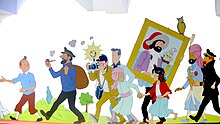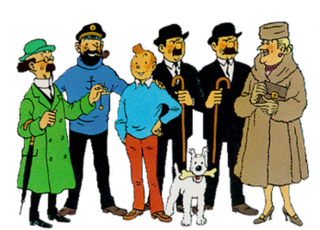
The Adventures of Tintin is a series of 24 comic albums created by Belgian cartoonist Georges Remi, who wrote under the pen name Hergé. The series was one of the most popular European comics of the 20th century. By 2007, a century after Hergé's birth in 1907, Tintin had been published in more than 70 languages with sales of more than 200 million copies, and had been adapted for radio, television, theatre, and film.

The Red Sea Sharks is the nineteenth volume of The Adventures of Tintin, the comic series by Belgian cartoonist Hergé. The story was initially serialised weekly in Belgium's Tintin magazine from October 1956 to January 1958 before being published in a collected volume by Casterman in 1958. The narrative follows the young reporter Tintin, his dog Snowy, and his friend Captain Haddock as they travel to the fictional Middle Eastern kingdom of Khemed with the intention of aiding the Emir Ben Kalish Ezab in regaining control after a coup d'état by his enemies, who are financed by slave traders led by Tintin's old nemesis Rastapopoulos.

The Castafiore Emerald is the twenty-first volume of The Adventures of Tintin, the comics series by Belgian cartoonist Hergé. It was serialised weekly from July 1961 to September 1962 in Tintin magazine. In contrast to the previous Tintin books, Hergé deliberately broke the adventure formula he had created: it is the only book in the series where the characters remain at Marlinspike Hall, Captain Haddock's family estate, and neither travel abroad nor confront dangerous criminals. The plot concerns the visit of the opera singer Bianca Castafiore and the subsequent theft of her emerald.
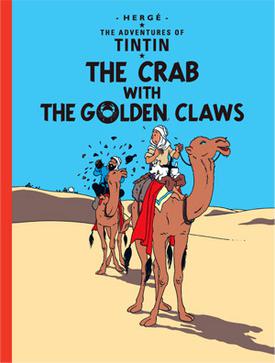
The Crab with the Golden Claws is the ninth volume of The Adventures of Tintin, the comics series by Belgian cartoonist Hergé. The story was serialised weekly in Le Soir Jeunesse, the children's supplement to Le Soir, Belgium's leading francophone newspaper, from October 1940 to October 1941 amidst the German occupation of Belgium during World War II. Partway through serialisation, Le Soir Jeunesse was cancelled and the story began to be serialised daily in the pages of Le Soir. The story tells of young Belgian reporter Tintin and his dog Snowy, who travel to Morocco to pursue a gang of international opium smugglers. The story marks the first appearance of main character Captain Haddock.

The Secret of the Unicorn is the eleventh volume of The Adventures of Tintin, the comics series by Belgian cartoonist Hergé. The story was serialised daily in Le Soir, Belgium's leading francophone newspaper, from June 1942 to January 1943 amidst the Nazi German occupation of Belgium during World War II. The story revolves around young reporter Tintin, his dog Snowy, and his friend Captain Haddock, who discover a riddle left by Haddock's ancestor, the 17th century Sir Francis Haddock, which could lead them to the hidden treasure of the pirate Red Rackham. To unravel the riddle, Tintin and Haddock must obtain three identical models of Sir Francis's ship, the Unicorn, but they discover that criminals are also after these model ships and are willing to kill in order to obtain them.

Red Rackham's Treasure is the twelfth volume of The Adventures of Tintin, the comics series by Belgian cartoonist Hergé. The story was serialised daily in Le Soir, Belgium's leading francophone newspaper, from February to September 1943 amidst the German occupation of Belgium during World War II. Completing an arc begun in The Secret of the Unicorn, the story tells of young reporter Tintin and his friend Captain Haddock as they launch an expedition to the Caribbean to locate the treasure of the pirate Red Rackham.
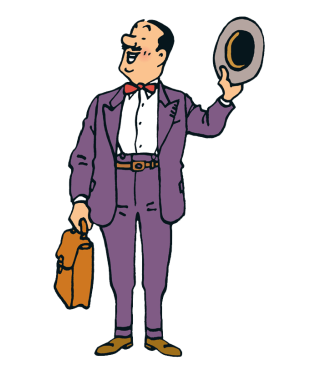
Jolyon Wagg is a fictional character in The Adventures of Tintin, the comics series by Belgian cartoonist Hergé. He is a gregarious, simple, and overbearing man who enters the story by barging in uninvited.

Land of Black Gold is the fifteenth volume of The Adventures of Tintin, the comics series by Belgian cartoonist Hergé. The story was commissioned by the conservative Belgian newspaper Le Vingtième Siècle for its children's supplement Le Petit Vingtième, in which it was initially serialised from September 1939 until the German invasion of Belgium in May 1940, at which the newspaper was shut down and the story interrupted. After eight years, Hergé returned to Land of Black Gold, completing its serialisation in Belgium's Tintin magazine from September 1948 to February 1950, after which it was published in a collected volume by Casterman in 1950. Set on the eve of a European war, the plot revolves around the attempts of young Belgian reporter Tintin to uncover a militant group responsible for sabotaging oil supplies in the Middle East.

Professor Cuthbert Calculus is a fictional character in The Adventures of Tintin, the comics series by Belgian cartoonist Hergé. He is Tintin's friend, an absent-minded professor and half-deaf physicist, who invents many sophisticated devices used in the series, such as a one-person shark-shaped submarine, the Moon rocket, and an ultrasound weapon. Calculus's deafness is a frequent source of humour, as he repeats back what he thinks he has heard, usually in the most unlikely words possible. He does not admit to being near-deaf and insists he is only slightly hard of hearing in one ear, occasionally making use of an ear trumpet to hear better.

Tintin and the Blue Oranges is a 1964 Franco-Spanish film directed by Philippe Condroyer and starring Jean-Pierre Talbot as Tintin. It was the second live-action film, with an original story based on characters from the comic book series The Adventures of Tintin, written and drawn by the Belgian artist Hergé. The accompanying book version is in photos and text rather than the usual comic-book style.
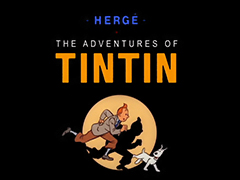
The Adventures of Tintin is an animated television series co-produced and animated by French animation studio Ellipse Programme and Canadian studio Nelvana Limited. The series is based on the comic book series of the same name by Belgian cartoonist Hergé. 39 half-hour episodes were produced over the course of three seasons, originally airing in France, Canada, and the United States between 1991 and 1992.

Hergé's Adventures of Tintin is the first animated television series based on Hergé's popular comic book series, The Adventures of Tintin. The series was produced by Belvision Studios and first aired in 1957. After two books were adapted in black and white, eight books were then adapted in colour, each serialised into a set of five-minute episodes, with 103 episodes produced.

Tintin – Le Temple du Soleil, subtitled Le Spectacle Musical, is a 2002 Belgian musical in two acts with music by Dirk Brossé, lyrics and scenario by Seth Gaaikema and Frank van Laecke and adapted to French by Didier Van Cauwelaert, based on two of The Adventures of Tintin by Hergé: The Seven Crystal Balls (1948) and Prisoners of the Sun (1949). It is the French-language version of the Dutch show Kuifje – De Zonnetempel that premiered in 2001. It premièred in Charleroi in 2002 and was scheduled for Paris in 2003 but was cancelled.

Marlinspike Hall is Captain Haddock's country house and family estate in The Adventures of Tintin, the comics series by Belgian cartoonist Hergé.
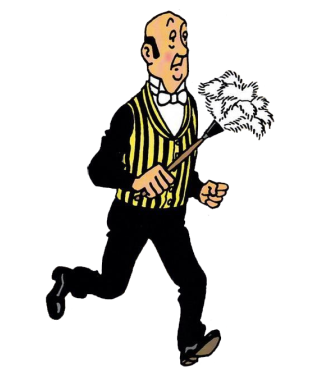
Nestor is a fictional character in The Adventures of Tintin, the comics series by Belgian cartoonist Hergé. He is the long-suffering butler of Marlinspike Hall.
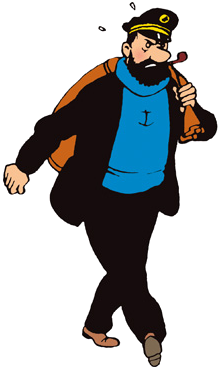
Captain Archibald Haddock is a character in the comic book series The Adventures of Tintin. He is Tintin's best friend, a seafaring captain in the Merchant Navy or Merchant Marine, who was introduced in The Crab with the Golden Claws. Haddock was initially depicted as a weak and alcoholic character, but in later albums he became more respectable and genuinely heroic. Although when introduced Haddock has command of a freighter, in later volumes he is clearly retired. The Captain's coarse humanity and sarcasm acts as a counterpoint to Tintin's often implausible heroism; he is always quick with a dry comment whenever the boy reporter gets too idealistic.

Snowy is a fictional character in The Adventures of Tintin, the comics series by Belgian cartoonist Hergé. Snowy is a white Wire Fox Terrier who is a companion to Tintin, the series' protagonist. Snowy made his debut on 10 January 1929 in the first installment of Tintin in the Land of the Soviets, which was serialised in Le Petit Vingtième until May 1930.







